Measure of Union in Terms of Measure of Intersection
From the definition of a measure, we require
The primary utility of this result is to prove the measure theory inclusion exclusion principal, with the base case there being a more intuitively obvious version of the above
and resembling the standard inclusion exclusion principle, where measuring the union of the two sets is equivalent to measuring them separately, and then accounting for double counting the overlap:

Proof
Consider that:
and hence:
given that
Now, given the sum of the above expressions in terms of